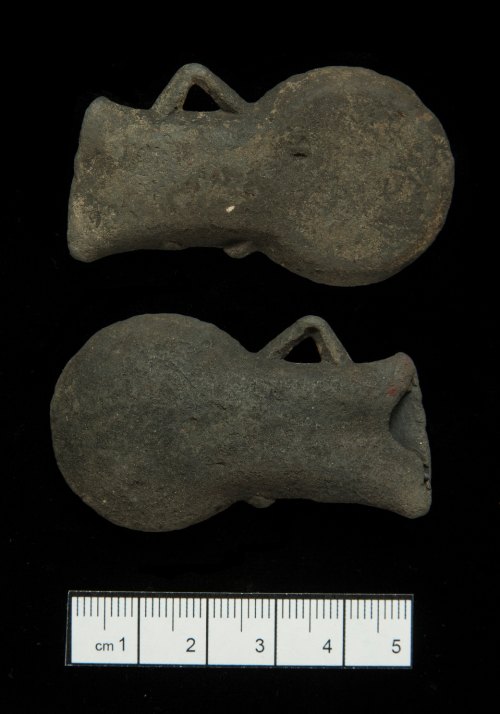
Image use policy
Our images can be used under a CC BY attribution licence (unless stated otherwise).
AMPULLA
Unique ID: MAS-D100029
Object type certainty: Certain
Workflow
status: Published ![]()
An incomplete, flask shaped ampulla made of lead dating to the late Medieval period, around AD 1350 to 1500. These objects are believed to have been used to transport holy liquid from pilgrim sites. The ampulla, found in the River Wear, has a rounded body that extends upwards into the neck and diverges outwards towards the top. One handle on the side of the neck is intact and the remains of a second handle is visible on the other side of the neck. The obverse side of the ampulla is rounded and there are no visible decorations remaining. A relief decoration of a small equal-armed cross within a circle is visible under raking light on the reverse, flat side of the body of the object.These are normally associated with Christian cross symbology.
Notes:
Holy water bottles made of lead were often brought from pilgrimage places as a souvenir. There is some suggestion that they were used in agricultural blessing ceremonies with the contents sprinkled on the ground during prayers and then the ampulla discarded, alternatively they were buried with their contents (
The object is being conserved/researched at Durham University as part of the Durham River Wear Assemblage Project
Class:
Religion or Ritual
Sub class: Religous or Ritual Container
Subsequent actions
Current location of find: Durham University
Subsequent action after recording: Submitted as wreck to the Receiver of Wreck
Chronology
Broad period: MEDIEVAL
Period from: MEDIEVAL
Period to: MEDIEVAL
Dimensions and weight
Quantity: 1
Length: 56 mm
Width: 22 mm
Weight: 64 g
Discovery dates
Date(s) of discovery: Thursday 15th September 2016
Personal details
Found by: This information is restricted for your login.
Other reference numbers
Museum accession number: B.3399
Materials and construction
Spatial coordinates
4 Figure: NZ2742
Four figure Latitude: 54.77219974
Four figure longitude: -1.58182606
1:25K map: NZ2742
1:10K map: NZ24SE
Display four figure position on What3Words
Unmasked grid reference accurate to a 1 metre square.
References cited
- Anderson, W, 2010. Blessing the Fields? A Study of Late-medieval Ampullae from England and Wales. Routledge Oxford : Medieval Archaeology, 182-203 ,
Similar objects

Find number: MAS-1F5444
Object type: BEAD
Broadperiod: POST MEDIEVAL
Twenty-six long drawn beads with a single cylindrical central perforation extending along the length of the bead. Varying in size, the beads m…
Workflow: Published![]()

Find number: MAS-D100193
Object type: ENGINE
Broadperiod: NINETEENTH CENTURY
Unidentified non-ferrous object that probably represents part of a ships engine or fixtures and fittings. It appears constructed from a copper…
Workflow: Published![]()

Find number: MAS-D100178
Object type: TOOTHBRUSH
Broadperiod: POST MEDIEVAL
This find consists of a brush handle and head manufactured from either bone, horn or ivory, with the bristles missing. The item is approximate…
Workflow: Published![]()


